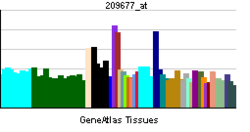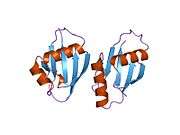PRKCI
| View/Edit Human | View/Edit Mouse |
Protein kinase C iota type is an enzyme that in humans is encoded by the PRKCI gene.[4][5][6]
Function
This gene encodes a member of the protein kinase C (PKC) family of serine/threonine protein kinases. The PKC family comprises at least eight members, which are differentially expressed and are involved in a wide variety of cellular processes. This protein kinase is calcium-independent and phospholipid-dependent. It is not activated by phorbolesters or diacylglycerol. This kinase can be recruited to vesicle tubular clusters (VTCs) by direct interaction with the small GTPase RAB2, where this kinase phosphorylates glyceraldehyde-3-phosphate dehydrogenase (GAPD/GAPDH) and plays a role in microtubule dynamics in the early secretory pathway. This kinase is found to be necessary for BCL-ABL-mediated resistance to drug-induced apoptosis and therefore protects leukemia cells against drug-induced apoptosis. There is a single exon pseudogene mapped on chromosome X.[6]
Interactions
PRKCI has been shown to interact with:
References
- ↑ "Drugs that physically interact with Protein kinase C iota type view/edit references on wikidata".
- ↑ "Human PubMed Reference:".
- ↑ "Mouse PubMed Reference:".
- ↑ Mazzarella R, Ciccodicola A, Esposito T, Arcucci A, Migliaccio C, Jones C, Schlessinger D, D'Urso M, D'Esposito M (Apr 1995). "Human protein kinase C Iota gene (PRKCI) is closely linked to the BTK gene in Xq21.3". Genomics. 26 (3): 629–31. doi:10.1016/0888-7543(95)80190-W. PMID 7607695.
- ↑ De Donato M, Gallagher DS, Davis SK, Stelly DM, Taylor JF (April 2002). "The assignment of PRKCI to bovine chromosome 1q34-->q36 by FISH suggests a new assignment to human chromosome 3". Cytogenetics and Cell Genetics. 95 (1-2): 79–81. doi:10.1159/000057021. PMID 11978974.
- 1 2 "Entrez Gene: PRKCI protein kinase C, iota".
- ↑ Zemlickova E, Dubois T, Kerai P, Clokie S, Cronshaw AD, Wakefield RI, Johannes FJ, Aitken A (Aug 2003). "Centaurin-alpha(1) associates with and is phosphorylated by isoforms of protein kinase C". Biochemical and Biophysical Research Communications. 307 (3): 459–65. doi:10.1016/s0006-291x(03)01187-2. PMID 12893243.
- ↑ Lim YP, Low BC, Lim J, Wong ES, Guy GR (Jul 1999). "Association of atypical protein kinase C isotypes with the docker protein FRS2 in fibroblast growth factor signaling". The Journal of Biological Chemistry. 274 (27): 19025–34. doi:10.1074/jbc.274.27.19025. PMID 10383403.
- ↑ Tisdale EJ (Feb 2002). "Glyceraldehyde-3-phosphate dehydrogenase is phosphorylated by protein kinase Ciota /lambda and plays a role in microtubule dynamics in the early secretory pathway". The Journal of Biological Chemistry. 277 (5): 3334–41. doi:10.1074/jbc.M109744200. PMID 11724794.
- ↑ Sanchez P, De Carcer G, Sandoval IV, Moscat J, Diaz-Meco MT (May 1998). "Localization of atypical protein kinase C isoforms into lysosome-targeted endosomes through interaction with p62". Molecular and Cellular Biology. 18 (5): 3069–80. doi:10.1128/mcb.18.5.3069. PMC 110686
 . PMID 9566925.
. PMID 9566925. - ↑ Kohjima M, Noda Y, Takeya R, Saito N, Takeuchi K, Sumimoto H (Dec 2002). "PAR3beta, a novel homologue of the cell polarity protein PAR3, localizes to tight junctions". Biochemical and Biophysical Research Communications. 299 (4): 641–6. doi:10.1016/s0006-291x(02)02698-0. PMID 12459187.
- ↑ Balendran A, Biondi RM, Cheung PC, Casamayor A, Deak M, Alessi DR (Jul 2000). "A 3-phosphoinositide-dependent protein kinase-1 (PDK1) docking site is required for the phosphorylation of protein kinase Czeta (PKCzeta ) and PKC-related kinase 2 by PDK1". The Journal of Biological Chemistry. 275 (27): 20806–13. doi:10.1074/jbc.M000421200. PMID 10764742.
- ↑ Diaz-Meco MT, Municio MM, Sanchez P, Lozano J, Moscat J (Jan 1996). "Lambda-interacting protein, a novel protein that specifically interacts with the zinc finger domain of the atypical protein kinase C isotype lambda/iota and stimulates its kinase activity in vitro and in vivo". Molecular and Cellular Biology. 16 (1): 105–14. PMC 230983
 . PMID 8524286.
. PMID 8524286.
Further reading
- Suzuki A, Akimoto K, Ohno S (Jan 2003). "Protein kinase C lambda/iota (PKClambda/iota): a PKC isotype essential for the development of multicellular organisms". Journal of Biochemistry. 133 (1): 9–16. doi:10.1093/jb/mvg018. PMID 12761193.
- Fields AP, Regala RP (Jun 2007). "Protein kinase C iota: human oncogene, prognostic marker and therapeutic target". Pharmacological Research. 55 (6): 487–97. doi:10.1016/j.phrs.2007.04.015. PMC 2705893
 . PMID 17570678.
. PMID 17570678. - Ruegg CL, Strand M (Oct 1991). "A synthetic peptide with sequence identity to the transmembrane protein GP41 of HIV-1 inhibits distinct lymphocyte activation pathways dependent on protein kinase C and intracellular calcium influx". Cellular Immunology. 137 (1): 1–13. doi:10.1016/0008-8749(91)90051-C. PMID 1832084.
- Chowdhury IH, Koyanagi Y, Kobayashi S, Hamamoto Y, Yoshiyama H, Yoshida T, Yamamoto N (May 1990). "The phorbol ester TPA strongly inhibits HIV-1-induced syncytia formation but enhances virus production: possible involvement of protein kinase C pathway". Virology. 176 (1): 126–32. doi:10.1016/0042-6822(90)90237-L. PMID 1970444.
- Ruegg CL, Strand M (May 1990). "Inhibition of protein kinase C and anti-CD3-induced Ca2+ influx in Jurkat T cells by a synthetic peptide with sequence identity to HIV-1 gp41". Journal of Immunology. 144 (10): 3928–35. PMID 2139676.
- Jakobovits A, Rosenthal A, Capon DJ (Apr 1990). "Trans-activation of HIV-1 LTR-directed gene expression by tat requires protein kinase C". The EMBO Journal. 9 (4): 1165–70. PMC 551792
 . PMID 2182321.
. PMID 2182321. - Fields AP, Bednarik DP, Hess A, May WS (May 1988). "Human immunodeficiency virus induces phosphorylation of its cell surface receptor". Nature. 333 (6170): 278–80. doi:10.1038/333278a0. PMID 3259291.
- Chirmule N, Goonewardena H, Pahwa S, Pasieka R, Kalyanaraman VS, Pahwa S (Aug 1995). "HIV-1 envelope glycoproteins induce activation of activated protein-1 in CD4+ T cells". The Journal of Biological Chemistry. 270 (33): 19364–9. doi:10.1074/jbc.270.33.19364. PMID 7642615.
- Ward NE, Gravitt KR, O'Brian CA (Jan 1995). "Inhibition of protein kinase C by a synthetic peptide corresponding to cytoplasmic domain residues 828-848 of the human immunodeficiency virus type 1 envelope glycoprotein". Cancer Letters. 88 (1): 37–40. doi:10.1016/0304-3835(94)03610-U. PMID 7850771.
- Gupta S, Aggarwal S, Kim C, Gollapudi S (Mar 1994). "Human immunodeficiency virus-1 recombinant gp120 induces changes in protein kinase C isozymes--a preliminary report". International Journal of Immunopharmacology. 16 (3): 197–204. doi:10.1016/0192-0561(94)90013-2. PMID 8206685.
- Selbie LA, Schmitz-Peiffer C, Sheng Y, Biden TJ (Nov 1993). "Molecular cloning and characterization of PKC iota, an atypical isoform of protein kinase C derived from insulin-secreting cells". The Journal of Biological Chemistry. 268 (32): 24296–302. PMID 8226978.
- Diaz-Meco MT, Municio MM, Sanchez P, Lozano J, Moscat J (Jan 1996). "Lambda-interacting protein, a novel protein that specifically interacts with the zinc finger domain of the atypical protein kinase C isotype lambda/iota and stimulates its kinase activity in vitro and in vivo". Molecular and Cellular Biology. 16 (1): 105–14. PMC 230983
 . PMID 8524286.
. PMID 8524286. - Parada NA, Cruikshank WW, Danis HL, Ryan TC, Center DM (Feb 1996). "IL-16- and other CD4 ligand-induced migration is dependent upon protein kinase C". Cellular Immunology. 168 (1): 100–6. doi:10.1006/cimm.1996.0054. PMID 8599832.
- Conant K, Ma M, Nath A, Major EO (Mar 1996). "Extracellular human immunodeficiency virus type 1 Tat protein is associated with an increase in both NF-kappa B binding and protein kinase C activity in primary human astrocytes". Journal of Virology. 70 (3): 1384–9. PMC 189957
 . PMID 8627654.
. PMID 8627654. - Díaz-Meco MT, Municio MM, Frutos S, Sanchez P, Lozano J, Sanz L, Moscat J (Sep 1996). "The product of par-4, a gene induced during apoptosis, interacts selectively with the atypical isoforms of protein kinase C". Cell. 86 (5): 777–86. doi:10.1016/S0092-8674(00)80152-X. PMID 8797824.
- Holmes AM (Nov 1996). "In vitro phosphorylation of human immunodeficiency virus type 1 Tat protein by protein kinase C: evidence for the phosphorylation of amino acid residue serine-46". Archives of Biochemistry and Biophysics. 335 (1): 8–12. doi:10.1006/abbi.1996.0476. PMID 8914829.
- Murray NR, Fields AP (Oct 1997). "Atypical protein kinase C iota protects human leukemia cells against drug-induced apoptosis". The Journal of Biological Chemistry. 272 (44): 27521–4. doi:10.1074/jbc.272.44.27521. PMID 9346882.
- Borgatti P, Zauli G, Cantley LC, Capitani S (Jan 1998). "Extracellular HIV-1 Tat protein induces a rapid and selective activation of protein kinase C (PKC)-alpha, and -epsilon and -zeta isoforms in PC12 cells". Biochemical and Biophysical Research Communications. 242 (2): 332–7. doi:10.1006/bbrc.1997.7877. PMID 9446795.
- Sanchez P, De Carcer G, Sandoval IV, Moscat J, Diaz-Meco MT (May 1998). "Localization of atypical protein kinase C isoforms into lysosome-targeted endosomes through interaction with p62". Molecular and Cellular Biology. 18 (5): 3069–80. doi:10.1128/mcb.18.5.3069. PMC 110686
 . PMID 9566925.
. PMID 9566925.






